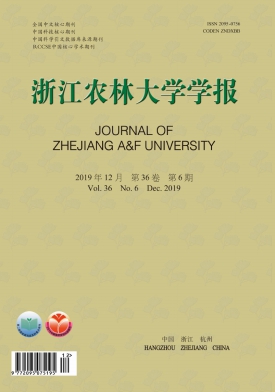-
转录因子(transcription factors,TFs)又称反式作用元件,能够直接或间接与基因启动子区域顺式作用元件发生特异性结合,并调控基因的转录。GRAS蛋白是近年来发现在植物中特有的一类TFs,其命名由最初被发现的3个成员GAI(gibberellic acid insensitive),RGA(repressor of GA1-3 mutant)和SCR(scarecrow)的特征字母而来。GRAS家族成员众多,包含10个主要亚家族,广泛参与植物生长发育、激素信号的转导、光信号通路的转导、根部辐射形态的形成、分生组织的维持以及逆境胁迫的响应等过程[1]。目前,在全基因组上挖掘GRAS TFs家族成员的研究工作已在多个物种,如菘蓝Isatis indigotica,木麻黄Casuarina glauca,丹参Salvia miltiorrhiza,拟南芥Arabidopsis thaliana和水稻Oryza sativa等物种中展开。部分GRAS家族成员的功能主要在水稻和拟南芥等模式植物进行了系统研究,但在药用植物中,GRAS候选转录因子的挖掘与功能解析的研究工作进展相对缓慢。本研究将对GRAS家族蛋白的结构特征、功能特性以及在药用植物中的最新研究进展进行综述,在总结前人研究成果的基础上,结合自身的研究展开分析,以期为后续在药用植物中开展对GRAS TFs家族成员的功能及应用研究提供思路和参考。
HTML
-
GRAS蛋白一般由400~770个氨基酸残基组成,不同家族成员的氨基酸序列和长度一般存在较大的差异。典型的GRAS蛋白具有高度保守的羧基端(C-Terminal,C端)(图 1),其C端一般为组氨酸和天门冬氨酸组成的基序VHIID(valine,V,缬氨酸;histidine,H,组氨酸;isoleucine,I,异亮氨酸;D-aspartic acid,D, D-天冬氨酸)。在VHIID两侧是富含亮氨酸结构的LR Ⅰ(leucine-rich region Ⅰ,LR Ⅰ)和LR Ⅱ(leucine-rich region Ⅱ,LR Ⅱ),LR Ⅰ基序中包含1个核定位信号区域(nuclear localization signal,NLS),而在LR Ⅱ则是包含LXXLL结构(L:亮氨酸;XX:2个任意氨基酸残基)。PFYRE基序(proline,P,脯氨酸;phenylalanine,F,苯丙氨酸;tyrosine,Y,酪氨酸;arginine,R,精氨酸;glutamic acid,E,谷氨酸)和RVER基序(arginine,R,精氨酸;valine,V,缬氨酸;glutamic acid,E,谷氨酸)靠近LR Ⅱ区域;而在最后的是SAW基序(ser,S,丝氨酸;ala,A,丙氨酸;trp,W,色氨酸)[2]。VHIID基序与两侧的LR Ⅰ和LR Ⅱ基序是GRAS家族蛋白的标志性结构域,几乎存在于所有的GRAS家族成员中,该结构域在后续的实验中被证明参与蛋白间和蛋白与核酸间的相互作用[3]。迄今为止,GRAS蛋白PFYRE和SAW基序的具体功能仍不清楚;但由于这2个结构较为保守,暗示它们对维持蛋白的空间结构和生物功能有重要的作用[4]。GRAS蛋白的氨基端(N-terminal,N端)是一个长度和氨基酸序列组成均可高度变化的伸展区域,暗示该区域与各个亚家族功能特异性密切相关[5]。
-
目前,仅有从菘蓝,木麻黄,丹参,蓖麻Ricinus communis,百脉根Lotus japonicus和莲Nelumbo nucifera等药用植物中有分离与鉴定GRAS转录因子家族成员的研究报道(表 1)。十字花科Cruciferae菘蓝又名茶蓝、板蓝根,以干燥叶和根入药称“板蓝根”,叶入药称“大青叶”,具有清热解毒、凉血消斑的功效,可用于治疗温病发热、发斑、风热感冒、咽喉肿痛、丹毒、流行性乙型脑炎、肝炎和腮腺炎等症。利用全基因组数据,从菘蓝中分离了10个亚家族共41个GRAS基因成员;转录组测序表明:5个DELLA成员和5个PAT1成员都能响应甲基茉莉酸(MeJA)的诱导而显著上调;而1个DELLA成员、1个PAT1成员、2个LAS家族成员以及2个SCL4/7成员都显著下调。但41个成员的具体功能未知,有待于进一步研究[6]。木麻黄科Casuarinaceae木麻黄又称木贼叶木麻黄、木贼麻黄,以幼嫩枝叶或树皮入药。药性温、药味辛、苦。功效为宣肺止咳,行气止痛,温中止泻,利湿。可用于治疗感冒发热、咳嗽、疝气、腹痛、泄泻、痢疾、小便不利、脚气肿毒。目前从木麻黄的EST序列中鉴定了2个亚家族共11个GRAS基因成员,但各自功能未知[7]。从唇形科Labiatae丹参基因组中克隆了SHR,PAT1,SCL4/7和SCL3共4个亚家族5个GRAS成员,均在茎和叶片中的表达量较高。5个成员都响应GA诱导而显著上调,而SHR家族成员GRAS1,PAT1家族成员GRAS4,SCL4/7和GRAS5还响应乙烯的诱导而显著上调[8]。大戟科Euphorbiaceae蓖麻以根及叶入药。夏秋采根及叶,分别晒干或鲜用。叶能消肿拔毒、止痒、治疮疡肿毒、治湿疹搔痒。根能祛风活血、止痛镇静,用于风湿关节痛、破伤风、癫痫、精神分裂症。目前从从蓖麻基因组中分离9个亚家族共46个GRAS基因成员。然而,不同组织部位的转录组测序共检测到31个GRAS家族成员表达;其中17个GRAS家族成员在叶片中的表达最高,8个GRAS家族成员在根中的表达量最高,6个GRAS成员在种子的胚乳中的表达量较高。此外,还对其中36个GRAS成员在干旱、高盐、冷害和热胁迫处理下的表达特征进行了检测分析,发现其至少能响应其中1种非生物胁迫,表达量显著上调,暗示此36个GRAS家族成员在蓖麻中能够有效的抵抗非生物逆境的胁迫,具有重要的生物学意义[9]。豆科Laguminosae植物百脉根以根入药,味甘苦、微寒、无毒。功能主治下气、止渴、去热、除虚劳、补不足。目前,从百脉根基因组中鉴定了6个亚家族共18个GRAS基因成员。研究证实:2个GRAS蛋白家族成员RAD1能与RAM1蛋白互作,促进豆科植物百脉根丛生菌根的生长发育[10]。睡莲科Nymphaea tetragona植物莲以花蕾入药,味苦、甘、性平、归心、肝经;具有散瘀止血、祛湿消风的功效。常用于损伤呕血、血淋、崩漏下血、天泡湿疮、疥疮瘙痒;目前在其基因组中分离了9个亚家族共38个GRAS基因成员,但各成员的功能未知[11]。
-
依据结构特征及功能特点GRAS家族成员可划分为DELLA,HAM,LISCL,PAT1,LAS,SCR,SCL4/7,DLT,SHR和SCL3等10个主要亚家族[1]。目前在药用植物中围绕10个亚家族成员功能的具体研究报道甚少。在拟南芥、水稻等模式植物中对GRAS亚家族成员功能的最新研究能为药用植物的同类研究提供很好的参考(表 2)。
GRAS亚家族分类 功能描述 参考文献 SCR,SHR 2个亚类蛋白存在互作,正向调控根辐射形态的形成与发育、以及叶和芽的发育 [12-15] LISCL 主要调控植物根细胞的伸长以及细胞的分裂 [16-18] DELLA 主要在赤霉素、茉莉酸和光信号介导下调控植物的生长发育;对植物逆境胁迫以及生长发育也能起到重要的调控作用 [19-23] SCL3 SCL3主要在根的内皮层中表达,不仅在赤霉素/DELLA的调控途径中发挥重要作用,同时联合SHR/SCR转录因子共同调控根部细胞的伸长与分裂 [24-25] SCL4/7,LAS,HAM 调控植物顶端分生组织的分化 [26-31] PAT1 PAT1能与SCL蛋白互作调控光敏色素信号通路的转导;PAT1还受DELLA蛋白的调控参与GA信号介导的病害免疫应答 [32-37] DLT BR信号能够促进蛋白与DLT亚家族蛋白互作,下调控植物株型和谷粒的形态 [38-39] Table 2. Subfamily classification and brief description of GRAS transcription factors
-
植物根的生长发育主要由细胞分裂和分化来共同调节,而根的形成是由干细胞通过一系列不对称分裂产生根的内外皮层,再通过差异分化形成了形态各异的组织。SCR(scarecrow)和SHR(short-root)是GRAS TFs家族中2个亚家族,两者均作为正向调控因子调节拟南芥根辐射形态的生长,并对根单层细胞的形成起重要的调节作用[12-13]。对拟南芥的研究发现:SCR主要在根表皮细胞中表达,当SCR功能缺失突变时会影响细胞层的正常发育。SCR仅调控基本组织子细胞的分裂过程,而SHR不仅能影响根内皮层细胞的极性分化,还能在特定组织中激活SCR启动子,使SHR通过介导SCR来发挥调控子细胞分化的能力[14]。此外,SHR蛋白具有移动的特性;尽管其在中柱鞘细胞中特异表达,但却能够从外部的单层细胞转移至内皮层细胞中与SCR相互结合形成二聚体,共同激活SCR基因和相关下游靶基因的转录。SHR蛋白的VHIID基序和PFYRE基序的N末端序列能够稳定蛋白结构,使SHR跨膜运动能够顺利完成。SCR和SHR均能促进SIEL(short-root interacting embryonic lethal)的表达,而SIEL能够促进SHR移出中柱鞘细胞完成跨膜运动[15]。综上所述,SCR和SHR在转录关系上具有相互依赖性,所形成的SCR-SHR复合体能正向调节SCR。SCR和SHR除了在植物根部发育的过程中起重要作用外,还对植物叶和芽的发育起重要的调节作用。因此,此GRAS亚类转录因子的深入研究对以根和叶入药的药用植物具有重要意义。
-
对麝香百合Lilium longiflorum的研究表明:LISCL(Lilium longiflorum Scarecrow-Like)亚家族在植物转录调控中发挥着重要的作用。LlSCL蛋白N端具有转录激活活性,在减数分裂前期能与控制花药细胞减数分裂相关基因的启动子相结合,起转录激活的作用,促进细胞的分裂[16]。辐射松Pinus radiata的PrSCL1基因和欧洲板栗Castanea sativa的CsSCL1基因均在根部高通量表达,能够响应外源生长素的诱导,影响早期不定根细胞的伸长与发育[17]。烟草Nicotiana tabacum的LISCL亚家族成员NtGRAS1基因在根部表达量最高,促进根细胞的伸长[18]。由此可见,LISCL亚家族成员的功能主要是调控植物细胞的生长与分裂。
-
赤霉素(gibberellin,GA)为四环二萜类化合物,起调控植物生理的作用,如种子萌发、下胚轴伸长、植物的营养生长等。在GRAS TFs家族中,DELLA蛋白是研究最为深入的一类。最早在拟南芥中共发现了5个DELLA蛋白成员,随后在其他物种中也发现了DELLA的家族成员。DELLA蛋白的主要特征是在N末端含有DELLA保守结构域,该结构域对赤霉素信号的感知是必不可少的。DELLA蛋白作为GA信号通路中的关键调控元件,起负调控的作用,阻遏植物的生长发育。在信号转导途径中,GA能与赤霉素受体蛋白GID1(gibberellin insensitive dwarf 1)相结合形成GA/GID1复合体,并与DELLA蛋白N端的DELLA结构域相结合形成新的GA/GID1/DELLA三元复合体;随之26 S蛋白酶将DELLA蛋白泛素化并降解,从而解除DELLA蛋白对植物生长的抑制作用。研究还发现:DELLA蛋白能够与光敏色素互作因子PIFs(phytochrome interacting factors,PIFs)相互作用,通过阻遏PIFs对相应下游靶基因的转录激活,进而抑制光信号介导的植物生长发育[19]。
此外,茉莉酸(jasmonic acid,JA)作为一类重要的植物激素,不仅能够调控植物对病虫害的免疫防卫,同时对生长发育也产生重要的影响。植物TFs MYC2(myelocytomatosis 2)和茉莉酸阻遏蛋白JAZs(jasmonate ZIM-domain)处于茉莉酸信号通路的核心位置。研究发现:拟南芥DELLA蛋白能够与茉莉酸阻遏蛋白JAZ1(jasmonate ZIM-domain 1)相互作用,阻碍JAZ1对MYC2的抑制,进而释放出MYC2,促进MYC2与下游靶基因的结合,从而增强JA信号介导的MYC2的调控作用[20]。研究还发现:DELLA是一个功能多样的调控基因,对植物的干旱、冷害、一氧化氮(NO)等逆境胁迫以及植物的生长发育都能起到重要的调控作用[21]。利用比较转录组测序,LIU等[22]从兰科Orchidaceae药用植物金线莲Anoectochilus roxburghii中挖掘了11个编码DELLA蛋白的单基因簇,推测其受兰科共生菌诱导,能促进种子的萌发。在药用植物丹参中的研究发现,MYC2能够促进药用活性物质丹酚酸的代谢合成[23]。DELLA蛋白能否与JA信号通路中的JAZs和MYC2蛋白互作调控药用植物活性物质的代谢合成或是生长发育,尚无明确的报道。
-
SCL3(scarecrow-like 3)是GRAS TFs家族的另一重要亚家族成员。在拟南芥中研究发现:SCL3主要在根的内皮层中表达,对根的伸长起重要的调控作用;同时也参与植物地上和地下部分的器官发育。SCL3通过与DELLA蛋白互作来影响下游的GA信号通路,其作为正调控因子调节植物体内的GA平衡,从而影响生长发育[24]。SCL3不仅在GA/DELLA的调控途径中发挥重要作用,同时联合SHR/SCR转录因子共同调控根部细胞的伸长与分裂[25]。由此可见,SCL3亚家族成员的功能主要是在GA信号介导下调控植物根系的发育。对以根入药的药用植物而言,在收获前期用GA3进行诱导处理,有望提高产量,具有重要的研究价值。
-
GRAS家族中LAS亚家族成员在腋芽生长发育过程中起重要的调节作用。拟南芥AtLAS是控制叶腋分生组织发育的关键基因,其功能缺陷突变体由于在营养生长阶段失去分生能力导致不能形成侧枝[26]。目前已在番茄Solanum lycopersicum,水稻,黄瓜Cucumis sativus和结缕草Zoysia japonica等物种中发现具有相似功能的LAS基因[27]。OsMOC1是AtLAS在水稻中的同源基因,仅在腋芽中表达;过表达后增加分蘖数量;而OsMOC1缺失突变体则表现不分蘖,同时2个调控水稻分蘖的基因OsSH1和OsTB1也不表达[27-28]。
HAM(hairy meristem)是GRAS转录因子的亚家族之一,在矮牵牛Petunia hybrida中发现的PhHAM是最早被证明能够维持茎尖分生组织分化的相关基因;其通过维持顶端分生组织干细胞处于未分化的状态,使顶端分生组织具有不断分化的能力[12]。在拟南芥中,AtLAS也具有保持分生组织具有长久分化能力的功能;且PhHAM和AtLAS两者拥有相同的下游靶点,可通过相似的途径共同控制植物分生组织的生长发育[12, 27]。甘蓝型油菜Brassica napus中BnSCL1(SCR-Like 1,SCL1)也是HAM亚家族的一员;BnSCL1受生长素的调控来影响植物根的生长发育[12, 29]。这说明HAM亚家族成员的功能调控模式在不同物种中存在一定的差异。
近期,在陆地棉Gossypium hirsutum基因中也鉴定了4个SCL4/7亚家族成员,但功能未知[30]。FAMBRINI等[31]研究发现:向日葵Helianthus annuus HaGRASL基因隶属于GRAS SCL4/7亚家族。在拟南芥中超表达HaGRASL能降低植株体内GAs的含量,从而调控腋分生组织的起始分化。目前,已从菘蓝、木麻黄、丹参、蓖麻、百脉根、莲等6种药用植物中鉴定了GRAS SCL4/7亚家族的新成员,但关于其具体功能尚未见报道[6-11]。
-
光是重要的环境信号,对植物生长发育具有重要调节作用。不同的光波长、强度和光周期都会对植物生长产生影响[32]。在进化过程中,植物通过产生光敏色素来分辨不同的光信号,从而达到适应环境的目的。植物光敏色素主要分为A,B,C,D和E五大类。在GRAS转录因子家族中,拟南芥PAT1(phyto-chrome A signal transduction 1)和SCL21(SCR-Like 21)基因均参与光敏色素A的信号转导[33];由于AtPAT1缺少核定位信号结构,致使其定位于细胞质中,因此推测光敏色素A早期信号转导发生在细胞质中[34]。研究表明:AtPAT1和AtSCL21蛋白能相互作用,参与光信号的转导过程,但两者组织表达特征存在着明显的差异;PAT1亚家族成员AtSCL21在成熟种子中高通量表达,而AtPAT1在不同组织部位的表达量则较为均一;经远红光、红光、蓝光和白光处理后,SCL21表达量会下降,而PAT1则无明显变化,说明两者在光信号转导调控途径中的作用模式存在着较大差异[35]。AtSCL13归属于PAT1亚家族,不仅参与调控光敏色素A信号通路,同时也作为正调控因子参与红光下光敏色素B信号的转导[36]。研究表明:AtSCL13在细胞质和细胞核中都有表达,过表达AtSCL13能提高细胞对红光的敏感度。综合对比PAT1,SCL21以及SCL13的蛋白结构发现,SCL13在N端缺少一个EAISRRDL基序,影响基因在光敏色素信号通路中的功能。PAT1家族成员的完整时空调控模式还有待于更进一步深入的研究。此外研究还发现:水稻PAT1亚家族成员CIGR1(chitin-inducible gibberellin-respensive 1)和CIGR2(chitin-inducible gibberellin-respensive 2)基因的表达还受到DELLA蛋白的调控,参与GA信号介导的免疫应答反应,提高水稻的抗病能力[37]。
-
油菜素内酯类似物(brassinosteroids, BRs)被公认为第六大植物激素,其作用主要为调控植物细胞的伸长与分裂、叶片的形态、衰老等[38]。DLT(Dwarf and low-tillering)亚家族是水稻研究中发现的最新GRAS家族成员。XIAO等[39]研究发现:水稻GSK2蛋白激酶能够与DLT基因的启动子结合,调控DLT基因的表达,从而调控BRs的信号转导。研究还发现:在水稻中超表达OFP1(ovate family protein 1)能够拟制赤霉素(GA3)的合成,促使水稻植株体内产生高浓度的BRs,从而拟制水稻的生长。同时产生的BRs信号能够促进OFP1(ovate family protein 1)与DLT蛋白互作,调控水稻的株型和谷粒的形态。
3.1. SCR和SHR亚家族主要调控植物根辐射形态的形成与发育
3.2. LISCL亚家族主要调控植物细胞的伸长与分裂
3.3. DELLA亚家族在赤霉素、茉莉酸和光信号介导下调控植物的生长发育
3.4. SCL3亚家族在赤霉素信号介导下调控植物根系的发育
3.5. SCL4/7,LAS和HAM亚家族主要调控顶端分生组织的分化
3.6. PAT1亚家族调控光敏色素信号通路的转导和病害免疫应答
3.7. BR信号介导DLT亚家族成员调控植物株型和谷粒的形态
-
GRAS转录因子在植物生长、发育、环境胁迫响应、生长信号转导等方面发挥着重要的调控作用。目前围绕GRAS家族成员的功能研究主要从以下几方面展开:①GRAS TFs在GA, MeJA和BR信号通路中的调控作用特征;②GRAS TFs在光信号介导下的调控作用;③GRAS TFs对植物根系和叶片发育的调控作用特征;④GRAS TFs对植物株型和谷粒的形态调控作用;⑤GRAS TFs对腋生分生组织形成和维持的调控作用;⑥GRAS TFs响应病害等环境胁迫的分子调控机制。对整个GRAS家族而言,目前功能已知的家族成员所占比例较小,而且相关研究主要集中在模式植物拟南芥和水稻中。GRAS TFs在药用植物中的挖掘与应用研究报道甚少。近期,BAI等[8]研究发现:GRAS基因受到外源GA和Eth(Ethylene)的正调控促进丹参酮的积累,暗示GRAS TFs可通过GA或Eth信号介导参与丹参次级代谢物的生物合成。由此可见,GRAS TFs家族可能在药用活性物质的代谢合成过程中具有重要的调节作用。
随着“中医药现代化建设”国家战略的提出,利用现代生物技术手段提高中药材的品质,从药源确保中药材的品质是当今理论和应用研究的热点。因此,可从以下方面开展药用植物研究:①GRAS TFs依据保守结构域特征可划分成为10个主要的亚家族,每个家族成员的功能差别较大,目前每个亚家族保守结构域的完整分子作用特征还有待进一步深入的解析。②GRAS蛋白N端的可变序列也是功能分化的重要基序,对其功能进行系统的研究,具有重要的理论指导意义。③尽管目前通过常规的分子生物学和遗传学研究手段已鉴定一些GRAS家族成员,但每个成员的完整分子机制并不清晰。可以通过现代组学测序技术,结合关联分析,挖掘与GRAS家族成员互作的候选蛋白,并结合分子和生物化学分析技术解析和阐明其完整的调控网络。④GRAS TFs有些定位于细胞核,有些定位在细胞质中与其他TFs相结合形成TFs复合体而行使功能;同一GRAS TFs也可以与不同的蛋白成员相结合,在不同的信号途径(譬如GA信号、BRs信号、MeJA信号等)中发挥着完全不同的功能。因此,深入研究GRAS特定家族成员的类似功能,将在药用植物逆境胁迫和品质改良方面具有重要的应用前景。⑤目前在药用植物开展表观遗传调控是一个研究热点。因此可利用第3代转录组测序、甲基化测序等现代技术手段深入研究小RNA(MicroRNA),长链非编码RNA(lncRNA)和甲基化(Methylation)等表观修饰调控与GRAS TFs的协同调控作用模型。









 DownLoad:
DownLoad: